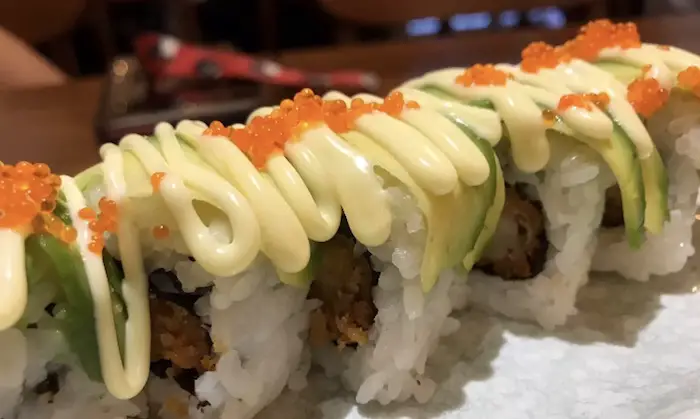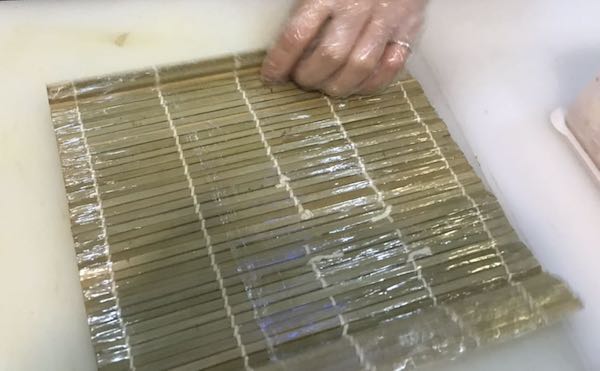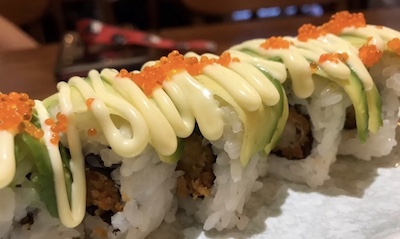We are reader supported. When you purchase through links on our site, we may earn an affiliate commission. Also, as an Amazon affiliate, we earn from qualifying purchases.

Crispy, juicy, and savory, the shrimp tempura rolls are to die for! If you want a beginner who is repulsive to the idea of raw fish, fall in love with sushi, serve this dish to him. This style of sushi roll has such as addictive taste that it doesn’t take long to quickly become someone’s favorite.
What is a shrimp tempura roll? This is a type of inside-out cooked sushi roll where the main ingredient is shrimp dipped in tempura batter and deep fried to get that crunchy texture. Other ingredients may include imitation crabmeat, avocado, cucumber, and sesame seeds.
I must admit that this sushi recipe demands a lot of preparation time and it is easier to order at a restaurant when you are craving badly for it. However, if you have the time to prepare your own shrimp tempura sushi roll at home, I can bet that the end results will be worth the time and effort.
Contents
Shrimp Tempura Roll Recipe
What you will need:
- Cooked and seasoned sushi rice
- large shrimp, peeled and deveined
- imitation crab sticks (surimi)
- Japanese mayo
- Ripe but firm avocado
- Japanese cucumber
- Toasted nori seaweed sheets
- Black sesame seeds
- Corn oil or vegetable oil for deep frying
- Masago (fish eggs)
For tempura batter:
- 3 1/2 tablespoons all-purpose flour
- 2 tablespoons cornstarch
- ½ teaspoon baking powder
- ¼ teaspoon curry powder
- 3-4 oz ice cold water, soda water or beer
- Salt and pepper to taste
Instructions
The first and most important step for any sushi recipe is cooking the rice which should not be too hard or too mushy, just perfect. I have created a guide to help beginners cook and season sushi rice perfectly, read it here.
While the sushi rice cools, you can prepare shrimps for the recipe. If you got the shrimps from a fishmonger near you then he may peel and devein them for a small fee.
However, if you bought them frozen from the supermarket or online sources like Catalina Offshore Products, chances are you may need to peel and devein them at home.
Peeling and Deveining Shrimps
To do this, thaw the frozen shrimps first. Now hold the shrimp in your left hand and twist the head part in the opposite direction using your right hand. Peel the outer hard covering or skin by working your way from the bottom to the top. Pull out any leg part that is still lingering on the shrimp flesh. Keep the tail part intact as this adds beauty to the roll.
Take a sharp Japanese sushi knife (see my favorite one) and create an incision throughout the upper body of the shrimp. You will see a fine black thread like thing where you have made the cut. Pull it out with the help of the knife. Make sure the entire vein comes out and there are no broken parts lefts inside.
Straightening Out Shrimps for Frying
When deep fried, the shrimps tend to curl, making it difficult to use them in the roll. So, here’s a trick to straighten out the shrimps so that they stay straight and look attractively when used inside the roll. To do this, take a sharp sushi knife like this and make two slits across the belly area at equal distance.
Flatten the shrimps on the cutting board and apply gentle pressure using your hands. If the shrimps are large in size, you may make more than 2 slits to straighten them out. Pat each shrimp dry.
Mix all the dry ingredients and coat the shrimps in the mixture. Dust-off the extra powder from the shrimps and now pour 3 to 4 oz of cold water or soda water to create an even batter mix. Whisk together to make a smooth batter.
Preparing Other Fillings
Use a sharp knife to finely chop the imitation crab sticks and mix it with mayonnaise. Thinly slice the Japanese cucumber into julienned pieces with skin on.
Cute the avocado into half, remove the pit, scoop out the flesh and cut into thin slices to be used as toppings over the sushi roll.
Deep Frying The Shrimp Tempura
Add oil to a medium-sized thick bottom pan and let the oil heat for a few minutes. Dip the shrimps one-by-one into the batter and deep fry until they turn golden brown in color. Do not try to add a lot of shrimps together as this will prevent the tempuras from getting fried evenly.
Assembling and Rolling The Sushi

This is the final step and an important one too. Place the bamboo mat on the kitchen counter and cover it with a plastic wrap. Put the Nori sheet on the mat and spread a layer of sushi rice over it. Leave a little gap along the edges.
Moisten your hands with water or tezu (water mixed with vinegar) and press gently to ensure that rice sticks to the Nori sheet. Sprinkle toasted black sesame seeds over the sushi rice.
Now, flip the seaweed to have the sushi rice part below and the Nori on the top. If you prefer the traditional maki style, you may tweak the recipe by skipping this part.
Cut the shrimp tempuras into half so that you have two equal pieces and arrange them in a straight line towards the middle of the sheet. Make sure the tail part protrudes out for an artistic appearance.
Next, take a spoonful of imitation crab meat salad and arrange in a straight line after the tempura. Add a few pieces of cucumber to add some freshness and green effect to the roll.
Now, lift the bamboo mat from your end and start rolling to make a compact cylinder. Press gently as you roll to ensure that the inner fillings stay together. Keep rolling until you reach the edge and seal the edges with a few drops of water. Remove the plastic wrap.
Toppings and garnishing
For the toppings, lift the avocado slices with the help of your sushi knife and arrange them one after another. Place the plastic sheet again and tightly hug the sushi roll with the bamboo mat to ensure that the avocado slices blend into shape.
Moisten the blade of your sushi knife and cut the shrimp tempura roll into 6-8 equal pieces with the plastic wrap intact. Now, remove the plastic and drizzle some Japanese mayo over the slices. Garnish with masago to score more points with the presentation.
Brief History Of Tempura In Japan
If you thought the tempuras were the result of modernization and westernization of the humble sushi rolls then you are mistaken. This style of tempura batter frying traces its origins to the mid-16th century when Japan was primarily a closed-port archipelago with restricted trading access with a few Dutch and Chinese traders.
The idea of tempura batter and deep frying came along with Catholicism when the Portuguese traders set their foot into the country. The term ‘tempura’ is derived from ‘tempora’, a Latin word which signifies to ‘The Ember Days’ when the Catholics do not eat meat. The Japanese mistook it to be the name of the dish and it is called tempura even today. Hilarious, but true!
The concept of deep fried food was new to Japan because unlike other parts of the world, the Japanese were oblivion to the frying technique. Interestingly China has some mention of fried foods in its history and the culinary culture also came to Japan much before the Portuguese arrived but it did not impress the Japanese as much as the tempuras did.
Some historians believe that the original Portuguese dish may have been inspired by an Indian dish called ‘pakora’, which is made in a similar fashion. The Portuguese probably took inspiration from this dish during their trading days in Goa, India.
According to Japanese chef Yoshi, use of the correct ingredients in the right quantities is the key to making good quality tempura. He likes using the authentic tempura flour available in Japan and also prefers using brown rice oil for frying tempuras.
Yoshi recommends the use of Brown Rice Oil because the tempuras turn out to be crispier and the oil doesn’t stay on the fried pieces. He also says that shrimp tempura rolls taste best with Ten-tsuyu dipping sauce, which is prepared by mixing soy sauce, mirin, and dashi (fish stock). Grated ginger or daikon radish may be served with tempura roll to add a zing to it.
Tempura’s Place In Japanese Cuisine Today
Today, tempura holds a special place in Japanese food culture and you will find them in various dishes ranging from sushi rolls to soba noodles. Besides shrimps, several types of white fish, imitation crab sticks and vegetables (sweet potatoes, shiitake mushrooms, eggplant, peppers, lotus roots, carrots, potatoes, onions, kabocha) may be used for making crispy tempuras.
If you are a vegetarian, you may still enjoy tempura roll sushi by substituting shrimps and imitation crab salad with substitute ingredients of your choice. The tempuras of today are an important part of Japanese food culture and the original recipe was twisted to suit the oriental tastes.
Tempura is an excellent example of Japanese brilliance at adapting foreign dishes and converting them into an original recipe that is uniquely Japanese.
5 Common Mistakes To Avoid When Making Shrimp Tempura Roll
#1. The crispiness of shrimp tempura is the most delicious aspect of this dish. However, it also includes other ingredients such as cucumber and avocado. Preparing tempura sushi rolls much in advance will result in moisture from avocado and cucumber seeping into the outer coat of tempura, making it soggy. To avoid this, you must ensure that you consume the roll immediately after it’s served.
#2. Slathering your tempura roll with too much of sauces is not needed. I would recommend that you avoid serving pickled ginger with cooked sushi as it has no role to play. When eating tempura, keep it free of additional flavors so that you can enjoy its authentic taste to the fullest.
#3. If the tempura batter mix is not icy cold, you cannot get the desired results. Make sure that the shrimps, as well as the batter mix, are freezing cold as this helps with achieving the right level of crispiness. I recommend using beer or carbonated water if you can. Plain water with crushed ice can also serve the purpose.
#4. Using the deep fryer to make shrimp tempura for a small group of family dinner may result in oil wastage. I suggest using a small thick bottom saucepan unless you are making rolls for a large group. You will get the same results with comparatively less amount of oil.
#5. Throwing away the remaining tempura batter is a shame after so much effort that goes into preparing it. You can use whatever vegetables you have in the kitchen to make a scrumptious side dish that can be enjoyed with shrimp tempura rolls.
Related Questions
Can I use the readymade tempura batter mix?
Yes. If you are in a hurry or wish to reduce the time spent in making the sushi rolls, use a readymade tempura batter mix instead. To make the batter, add 3 tablespoons of the instant mix and 3 tablespoons of icy cold water. Always keep the ratio 1:1 and let the batter sit for a few minutes before using.
How can you serve the shrimp tempuras?
They may be served as a snack, starter dish or used the main ingredient in popular sushi rolls like Caterpillar rolls (find the recipe here) and Dragon rolls (find the recipe here).
From my experience, I would suggest you prepare more tempuras than you need for rolls because some of them will disappear as soon as you take them out of the frying pan ;).
What makes tempura different from other fried foods?
The unique batter mix of tempura makes it different from other types of fried dishes. There are no bread crumbs and the frying technique is also less greasy.
What does shrimp tempura taste like?
The shrimp tempura is sweet, soft, and juicy inside, and crunchy on the outside. When balanced with vinegared sushi rice, cucumber strips, avocado slices, and crab meat, you get a delightful combo worth savoring.
Is shrimp tempura roll vegan and gluten-free?
The tempura batter usually contains all-purpose flour, cornstarch, baking soda, and curry powder, so it is vegan. But, some people may add whole eggs to the batter, which then makes it non-vegan. So, better ask about the ingredients when dining out at a restaurant.
The tempuras may be vegan, but they are not gluten-free for sure because they contain starch and are deep-fried too. If you are keen on eating tempuras while on a celiac diet, consider buying the gluten-free tempura batter from stores and make your own sushi so that there is no risk of contamination.

